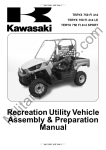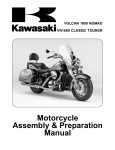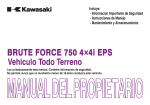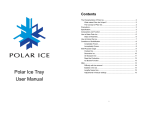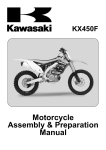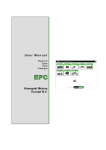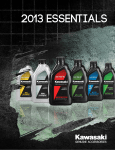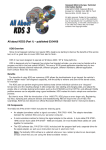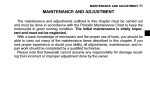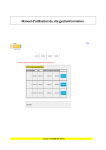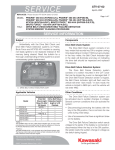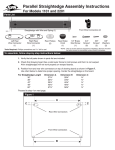Download All Terrain Vehicle Assembly & Preparation Manual
Transcript
BRUTE FORCE 750 4×4iEPS BRUTE FORCE 750 4×4i KVF750 4×4 EPS KVF750 4×4 All Terrain Vehicle Assembly & Preparation Manual Foreword In order to ship Kawasaki vehicles as efficiently as possible, they are partially disassembled before crating. Since some of the most commonly removed parts have a direct bearing on a vehicle’s reliability and safety, conscientious pre-sale assembly and preparation become extremely important. Good setup procedures can prevent needless warranty claims and give customers a greater sense of confidence in Kawasaki and their Kawasaki Dealers. This Assembly and Preparation Manual explains step by step procedures of the following items for all Kawasaki BRUTE FORCE 750 4×4i EPS, BRUTE FORCE 750 4×4i, KVF750 4×4 EPS, KVF750 4×4. WARNING WARNING indicates a hazardous situation which, if not avoided, could result in death or serious injury. CAUTION CAUTION indicates a hazardous situation which, if not avoided, could result in minor or moderate injury. NOTICE NOTICE is used to address practices not related to personal injury. NOTE 1. Uncrating 2. Assembly 3. Preparation ○This note symbol indicates points of particular The selling dealer assumes sole responsibility for any unauthorized modifications prior to sale. Refer to your Service Binder for any Service Bulletins specifying Factory Directed Modifications (Special Claims) which must be performed before the vehicle is ready for sale. Whenever you see the following symbols heed their instructions! Always follow safe operating and maintenance practices. Kawasaki Heavy Industries, Ltd. accepts no liability for any inaccuracies or omissions in this publication, although every possible care has been taken to make it as completely and accurately as possible. All procedures and specifications subject to change without prior notice. interest for more efficient and convenient operation. DANGER DANGER indicates a hazardous situation which, if not avoided, will result in death or serious injury. © 2011 Kawasaki Heavy Industries, Ltd Jan., 2011 Table of Contents Uncrating ...................................................................................... Opening Crate (US and Canadian Models only) ......................... Opening Crate (Other than US and Canadian Models)............... Parts Check ................................................................................. Assembly ...................................................................................... Handlebar.................................................................................... Hangtag....................................................................................... French Labels.............................................................................. Owner’s Manual .......................................................................... Preparation ................................................................................... Battery Service ............................................................................ Air Cleaner .................................................................................. Front Final Gear Case Oil ........................................................... Rear Final Gear Case Oil ............................................................ Front Brake.................................................................................. Rear Brake .................................................................................. Suspension.................................................................................. Tire Air Pressures........................................................................ Fuel ............................................................................................. Coolant ........................................................................................ Engine Oil.................................................................................... Throttle Lever and Cable ............................................................. Variable Differential Control Lever and Cable ............................ Rear Brake Light Switch Adjustment ........................................... Headlight Beam ........................................................................... Front Wheel Alignment ................................................................ Multifunction Meter ...................................................................... Fastener Check ........................................................................... Standard Torque Table ................................................................ Test Ride ..................................................................................... A&P Check List ........................................................................... 3 3 6 7 10 10 11 11 12 13 13 16 17 18 19 20 21 22 22 22 23 24 25 26 26 26 29 32 34 34 34 UNCRATING 3 Uncrating Opening Crate (US and Canadian Models only) Returnable Steel Crate (RSC): NOTICE To avoid damaging the front plastic guard, fold down the front end of the steel crate before removing the tie-downs. WARNING Crates have sharp edges and may have nails or screws that can cause cuts and injury. Always wear protective gloves, boots and eye protection when uncrating to prevent injury. A. Outer Cover • Remove the inner cover. WARNING The steel crate panel plates and fasteners have sharp edges. Always wear protective gloves, boots and eye protection when uncrating to prevent injury. A. Inner Cover To work efficiently, start work at the rear of the crate. Remove the hairpin clips (2), then push out the clevis pins (2) to disconnect the rear diagonal braces (2) from the rear upright. • a space about 6 m (20 ft) square to give • Clear yourself plenty of space to work. the crate upright on its base. • Place Remove the outer cover and inspect the unit • for concealed damage. If concealed damage • is evident, document the damage as outlined in the Kawasaki Warranty Policies and Procedures Manual before proceeding to uncrate the unit. Remove the cardboard cover. 4 UNCRATING A. Rear Upright B. Hairpin Clip C. Diagonal Brace the diagonal braces to pivot out and • Allow down to the ground. They remain attached • to the pallet. Install the hairpin clips (2) back into the braces for return shipment to KMM. A. Front Upright B. Hairpin Clip C. Diagonal Brace NOTE ○Note that the front upright is collapsible (The rear upright is not collapsible.). it up while removing the second pin. Af• Hold ter pin removal, allow the upright to collapse. A. Hairpin Clip B. Clevis Pin C. Diagonal Brace A. Front Upright B. Diagonal Brace the LH side rear diagonal brace, • Remove again allowing it to pivot down. At this time, down the front upright. To do so, lift up on • Lay the front upright (lower section) to disengage • the rear upright may be pivoted down, but it may not be necessary to do so. Only one upright must be pivoted down before rolling off the vehicle. In this example, the vehicle will be rolled out the front, which is shown later. Moving to the front, disconnect the front diagonal braces (2) from the front upright. Pull out the hairpin clips (2), push out the clevis pins (2), and allow each diagonal brace to pivot down to the ground. Install all pins and hairpin clips back into the braces for return shipment to KMM. its sockets from the pallet. A. Front Upright B. Lower Section UNCRATING 5 down the sides, remove the • Working tie-downs (2) which secure the vehicle to the crate pallet. A. Tie-down the upright may be pivoted down to the • Now ground. (It remains attached to the pallet.) Be • careful not to drop it on anyone. Roll off the vehicle. RETURN SHIPMENT (RSC) up slightly on the rear upright to disen• Pick gage its sockets. Pivot it down onto the crate pallet. Be careful not to drop on anyone. A. Rear Upright B. Socket these steps for the other upright. (The • Repeat front upright is shown in this example.) A. Front Upright B. Diagonal Brace the crate for return shipment. In this • Prepare example, we will begin at the rear of the crate. around the diagonal braces so that • Swing they will lay on the crate pallet. A. Front Upright B. Diagonal Brace A. Rear Upright B. Diagonal Brace clevis pins (4) and hairpin clips (4) are • The already installed into the braces. Notice that it is necessary to collapse one upright so that enough space exists for both uprights when laid down. 6 UNCRATING a space about 6 m (20 ft) square to give • Clear yourself plenty of space to work. the crate upright on its base. • Place the outer cover and inspect the unit • Remove for concealed damage. If concealed damage is evident, document the damage as outlined in the Kawasaki Warranty Policies and Procedures Manual before proceeding to uncrate the unit. Remove the cardboard cover. A. Rear Upright B. Clevis Pins and Hairpin Clips C. Front Upright items are discarded: • These -Outer Cover, Inner Cover, Tie-downs (Qty.2) the empty RSC may be stacked maxi• Now mum 12 high for return shipment. Each empty • Removing Panels a BPS3 square drive bit (ex. IM• Using PORT APEX Square Recess “Power Bits1/4 Hex-size #3” or MAGNA “Insert Bits-size #3” with quick change holder), remove the screws from the sides and ends. RSC weighs about 97 kg. (215 lbs.) so a stack of 12 is very heavy. The empty crates interlock at each corner for stability. No stacking bands are needed. Opening Crate (Other than US and Canadian Models) WARNING Crates have sharp edges and may have nails or screws that can cause cuts and injury. Always wear protective gloves, boots and eye protection when uncrating to prevent injury. A. “Power Bit (APEX)” WARNING Staples, nails and other fasteners have sharp points that can cause injury. Remove or bend into the wood all staples, nails or other fasteners in the crate base. Disposable Wooden Crate: out all the fasteners and remove the top • Take and sides of the crate. UNCRATING 7 the top and side panels of the wood • Remove crate. • Remove the inner cover. NOTICE Be careful not to puncture a tire with sharp fasteners when rolling off the vehicle from the crate base. the tie-downs (2) which secure the • Remove vehicle to the crate pallet and roll off the vehicle. A. Tie-downs Parts Check the parts including Owner’s Manual • Remove from the parts bag on the footboard. the battery electrolyte from the rear • Remove end of the chassis. A. Electrolyte 8 UNCRATING the parts against the illustrations. There may be minor differences between these • Check illustrations and the actual vehicle parts. UNCRATING 9 No. Part Name 1 French Label and Instruction for KVF750GCF Canadian Model only Instruction, Label Label, Vehicle Emission Information KVF750HCF Canadian Model only Instruction, Label Label, Vehicle Emission Information KVF750JCF Canadian Model only Instruction, Label Label, Vehicle Emission Information KVF750LCF Canadian Model only Instruction, Label Label, Vehicle Emission Information 2 French Labels for Canadian Model only Label, Age Label, General Label, Passenger Label, Tire Pressure Label, Trailer Towing Label, Shifting Label, Transmission Label, Protective Cover Label with Band, General for English Label with Band, General for French Label, Air Cleaner Information Cover, Label 3 French Labels and Instruction for European Model Instruction, Label Label, Protective Cover Label, Shifting Label, Transmission Label, Passenger Label, Air Cleaner Information 4 For US Model only Label with Band, General Label with Band, Exhaust Emission Air Index 5 Ignition Key 6 Battery Electrolyte, KMX14-BS 7 Owner’s Manual Qty Remarks 1 1 56030-0403 59465-0046 1 1 56030-0730 59465-0627 1 1 56030-0731 59465-0629 1 1 56030-0717 59465-0604 1 1 1 1 1 1 1 1 1 1 1 1 56040-1325 56071-0059 56071-0097 56071-0074 56071-0080 56071-0092 56070-0039 56070-1271 56030-0194 56030-0197 56033-0308 14092-0127 1 1 1 1 1 1 56030-0337 56070-1271 56071-0092 56070-0039 56071-0097 56033-0308 1 1 2 1 1 56030-0194 49007-0706 – 12 V 12 Ah – 10 ASSEMBLY Assembly Handlebar Handlebar Installation the screws (D = 5, L = 16) (4) to • Remove remove the front handlebar cover. A. Handlebar Clamp Bolts B. Handlebar C. Punched Mark D. Clamp Handlebar Clamp Bolt Tightening A. Screws B. Front Handlebar Cover the screws (D = 5, L = 14) (3) to • Remove remove the rear handlebar cover. the front clamp bolts first, and then • Tighten the rear clamp bolts to the specified torque. If the handlebar clamps are correctly installed, there will be no gap at the front and a gap at the rear after tightening. Handlebar Clamp Bolt Torque: 29 N·m (3.0 kgf·m, 22 ft·lb) A. Rear Handlebar Cover B. Screws C. Well Nuts NOTE ○Be careful not to drop the well nuts when you removing the rear handle cover. the handlebar clamp bolts and lift the • Loosen handlebar up. the handlebar to match its punched mark • Set to the upper edge of the gap between the handlebar clamp. A. B. C. D. ○It Front Clamp Bolts Rear Clamp Bolts No Gap Gap NOTE is recommended that the front handlebar cover should be installed after completing the steps in the “Throttle Lever and Cable” and “Differential Control Lever and Cable” sections in the PREPARATION chapter. ○It is recommended that the rear handlebar cover should be installed after completing the step in the “Throttle Lever Free Play Adjustment” in the PREPARATION chapter. ASSEMBLY 11 Hangtag French Labels Exhaust Emission Air Index Hangtag Installation (For US Model) For Canadian Model: is an exhaust emission air index hang• There tag included into the removed parts. Hang it NOTE ○Stick the French labels onto the English labels on the front fender, rear fender, or the seat only when required. to the left handlebar as shown. off any oil or grease from the English • Wipe labels. Refer to the following photographs in • the label locations. Peel each French label off the backing sheet and apply it over the English label. A. Exhaust Emission Air Index Hangtag (49007-0706) B. Left Grip NOTE ○This hangtag is not to be removed before sale. General Hangtag Installation (For US and Canadian Models) is a general hangtag included into the • There removed parts. Hang it to the right handlebar as shown. A. General Hangtag (56030-0194, US and Canada English Models) (56030-0197, Canada French Model) B. Right Grip NOTE ○This hangtag is not to be removed before sale. 1. Air Cleaner Information (56033-0308) 2. Age Recommendation Warning (56040 -1325) 3. General Warning (56071-0059) 4. Shifting Caution (56070-0092) 5. Protective Cover Warning (56070-1271) 12 ASSEMBLY For European Model: 6. Passenger Warning (56071-0097) 7. Tire Pressure & Maximum Loading Warning (56071-0074) 8. Transmission Warning (56070-0039) *9. Vehicle Emission Control Information French Label for KVF750GCF Canadian Model only (59465-0046) French Label for KVF750HCF Canadian Model only (59465-0627) French Label for KVF750JCF Canadian Model only (59465-0629) French Label for KVF750LCF Canadian Model only (59465-0604) Stick the label cover (14092-0127) onto the vehicle emission control information label (59465-xxxx). *: Attached in the back of the seat. 1. Important Air Cleaner Information (56033 -0308) 2. Shifting Caution (56071-0092) 3. Protective Cover Warning (56070-1271) • 4. Transmission Warning (56070-0039) 5. Passenger Warning (56071-0097) Owner’s Manual storage box is located on the left side • The front fender. Keep this Owner’s Manual and • 10. Trailer Towing Warning (56071-0080) other light items in this storage box. Keep the cover securely fastened with the strap when driving the vehicle. PREPARATION 13 A. B. C. D. Owner’s Manual Cover Strap Storage Box Preparation Battery Service Battery Removal The battery used in this vehicle is a sealed type and never needs to be refilled. Follow the procedures for activating a new battery to ensure the best possible battery performance. A. Bolt with Collar B. Screws with Collars C. Battery Cover Battery Activation Electrolyte Filling sure that the model name of the elec• Make trolyte container matches the model name of the battery. These names must be the same. Battery Model Name KVF750G/H/J/L: KMX14-BS Seat Removal the seat by pulling up the seat latch • Remove lever located at the left rear end of the seat, and then pull the seat up and to the rear. A. Model Name of the Electrolyte B. Model Name of the Battery NOTICE A. Seat Latch Lever the battery holder bolt (D = 6, L = 16) • Remove with collar (D = 6.3) to and screws (D = 6, L • = 18) (2) with collars (D = 6.3) (2) remove the battery cover. Take the battery out of the battery case. Be careful that any rubber dampers are not pulled out of position. Be sure to use the electrolyte container with the same model name as the battery since the electrolyte volume and specific gravity vary with the battery type. This is to prevent overfilling of the electrolyte, shorting the battery life, and deterioration of the battery performance. NOTICE Do not remove the aluminum sealing sheet from the filler ports until just prior to use. Be sure to use the dedicated electrolyte container for correct electrolyte volume. 14 PREPARATION WARNING The electrolyte contains sulfuric acid, which can cause severe burns. To avoid sulfuric acid burns, wear protective clothing and safety glasses when handling electrolyte. If the electrolyte touches the skin or eyes, wash the area with liberal amounts of water and seek medical attention for more severe burns. the battery on a level surface. • Place Check see that the sealing sheet has no • peeling,totears, or holes in it. Remove the sealing sheet. • NOTE ○The battery is vacuum sealed. If the sealing sheet has leaked air into the battery, it may require a longer initial charge. A. Strip of Caps B. Sealed Cells the electrolyte container upside down • Place with the six sealed cells into the filler ports of the battery. Hold the container level, push down to break the seals of all six cells. You will see air bubbles rising into each cell as the ports fill. NOTE ○Do not tilt the electrolyte container. A. Sealing Sheet B. Filler Ports the electrolyte container from the • Remove vinyl bag. the strip of caps from the container • Detach and set aside, these will be used later to seal the battery. NOTE ○Do not pierce or otherwise open the sealed cells of the electrolyte container. Do not attempt to separate individual cells. the electrolyte flow. • Check If no air are coming up from the filler • ports, orbubbles if the container cells have not emptied completely, tap the container a few times. NOTE ○Be careful not to have the battery fall down. PREPARATION 15 A. Air Bubbles B. Tap the Container the container in place. Don’t remove • Keep the container from the battery, the battery re- NOTICE Once the strip of caps is installed onto the battery, never remove the caps, nor add water or electrolyte to the battery. quires all the electrolyte from the container for proper operation. NOTICE Removal of the container before it is completely empty can shorten the service life of the battery. filling, let the battery sit for 20 ∼ 60 • After minutes with the electrolyte container kept in • • place, which is required for the electrolyte to fully permeate into the plates. Make sure that the container cells have emptied completely, and remove the container from the battery. Place the strip of caps loosely over the filler ports, press down firmly with both hands to seat the strip of caps into the battery (don’t pound or hammer). When properly installed, the strip of caps will be level with the top of the battery. NOTE ○Charging the battery immediately after filling can shorten service life. Initial Charge activated sealed batteries require an • Newly initial charge. Standard Charge: 1.2 A × 5 ∼ 10 hours a recommended battery charger, fol• Iflowusing the charger’s instructions for newly activated sealed battery. Kawasaki-recommended chargers: Battery Mate 150-9 OptiMate PRO 4-S/PRO S/PRO 2 Yuasa MB-2040/2060 Christie C10122S the above chargers are not available, use • Ifequivalent one. Let battery 30 minutes after initial charge, • then check sitvoltage using a voltmeter. (Voltage immediately after charging becomes temporarily high. For accurate measuring, let the battery sit for given time.) A. Strip of Caps 16 PREPARATION ○Charging NOTE rates will vary depending on how long the battery has been stored, temperature, and the type of charger used. If voltage is not at least 12.8 volts, repeat charging cycle. ○To ensure maximum battery life and customer satisfaction, it is recommended the battery be load tested at three times its amp-hour rating for 15 seconds. Re-check voltage and if less than 12.8 volts repeat the charging cycle and load test. If still below 12.8 volts the battery is defective. Air Cleaner Air Cleaner Element Inspection The foam air cleaner element on ATV models is oiled prior to shipping. However, over time the filter will dry and filtration performance will diminish. Pull release the snaps and remove the air cleaner housing cap and inspect the foam air cleaner element for proper oiling. • Battery Installation the ignition switch to OFF. • Turn Check the rubber dampers on the battery • holder that and the battery case are properly in • • • • place. Put the battery in place. Securely connect the red cable with protective cap and the black cable with the round terminal and the red tape to the (+) terminal, and then securely connect the black cable to the (–) terminal. On the battery (+) terminal, make sure the round terminal cable is on the red cable making about 30 degree angle with the red cable. Put a light coat of grease on the terminals to prevent corrosion. Cover the (+) terminal with its protective cap. A. Battery B. Positive Terminal (+) C. Negative Terminal (–) D. Red Tape E. About 30° the battery cover, bolt, screws (2) • Reinstall and collars (3) in the reverse order of removal. A. Air Cleaner Housing Cap B. Snaps the air cleaner element is dry, remove the • Ifscrew (D = 6, L = 5) and washer and pull out the air cleaner element and the element frame from the air cleaner housing. A. B. C. D. Air Cleaner Element Air Cleaner Housing Screw and Washer Element Frame the air filter element from the ele• Remove ment frame. PREPARATION 17 A. Air Cleaner Element B. Element Frame the air cleaner element with a • Saturate high-quality foam air filter oil (ex. Kawachem • • “Foam Filter Oil”, Bel Ray “Foam Filter Oil”, Maxima “FFT Foam Filter Treatment”, or equivalent cohesive type) and make sure that the oil is evenly applied throughout the air cleaner element. Squeeze out the excess oil, but do not wring the air cleaner element as this could cause tearing. In this case, too much oil is better than too little. Finally pat the inside of the air cleaner element with a paper towel to remove any excess oil. Install the air cleaner element to the element frame. Insert and tighten the screw to the specified torque. A. Front Hooks B. Front Receivers C. Rear Hooks D. Rear Receivers E. Latches F. Latch Lever up the rear end of the seat to make sure • Pull it is securely locked. Front Final Gear Case Oil Front Final Gear Case Oil Level Inspection the vehicle level front-to-rear and side-to • With -side, remove the filler cap from the front final gear case. Torque : 3.5 N·m (0.36 kgf·m, 31 in·lb) • Reinstall the air cleaner housing cap. Seat Installation the front hooks with the front receivers • Align and slide the seat forward. Make sure that the rear hooks align to their rear receivers. Push the seat with both hands around the rear hooks and make sure there is a click sound of the latches engaging. A. Front Final Gear Case B. Filler Cap C. Front Axle Shaft NOTICE Be careful not to allow any dirt or foreign materials to enter the front final gear case. the oil level. The oil level should come • Check to the bottom thread of the filler opening. If it is insufficient, add oil through the oil filler opening as necessary. 18 PREPARATION A. Front Final Gear Case B. Filler Opening C. Bottom Thread Front Final Gear Case Oil (Equivalent to engine oil) Type: A. Rear Final Gear Case B. Filler Cap NOTICE Be careful not to allow any dirt or foreign materials to enter the rear final gear case. API SG, SH, SJ, SL or SM with JASO MA, MA1 or MA2 Viscosity: SAE 10W-40 Capacity: 0.40 L (0.42 US qt) the oil level. The oil level should come • Check to the bottom thread of the filler opening. If Although 10W-40 engine oil is the recommended oil for most conditions, the oil viscosity may need to be changed to accommodate atmospheric conditions in your riding area. NOTE it is insufficient, add oil through the oil filler opening as necessary. ○Front and rear final gear cases use different types of oils. Use the specified type and brand of oil in each final gear case. Rear Final Gear Case Oil Type: Mobil Fluid 424, CITGO TRANSGARD TRACTOR HYDRAULIC FLUID or EXXON HYDRAUL 560 Capacity: 0.72 L (0.76 US qt) • Install the filler cap. Oil Filler Cap Torque: 29 N·m (3.0 kgf·m, 22 ft·lb) Rear Final Gear Case Oil Rear Final Gear Case Oil Level Inspection the vehicle level front-to-rear and side-to • With -side, remove the filler cap from the rear final gear case. NOTE ○Do not apply front final gear case oil into the rear final gear case. Apply only the specified oil. The rear final gear case contains brake plates which require a special oil type. Also the two different oil types for the rear gear case oil must not be mixed in use. PREPARATION 19 A. Rear Final Gear Case B. Filler Opening C. Bottom Thread • Install the filler cap. Oil Filler Cap Torque: 29 N·m (3.0 kgf·m, 22 ft·lb) Front Brake Front Brake Fluid Level Inspection the front brake reservoir horizontal, • Position and check that the fluid level in the reservoir is higher than the lower level line. A. Lower Level Line fluid level in the reservoir is lower than • Ifthethelower level line, check for fluid leaks in the • • front brake lines and fill the reservoir. Loosen the screws to remove the front brake fluid reservoir cap and diaphragm. Fill the reservoir to the upper level line with DOT4 brake fluid. Inside the front brake reservoir is a stepped line showing the upper level line. A. Upper Level Line WARNING When working with the disc brake, observe the precautions listed below. 1. Never reuse old brake fluid. 2. Do not use fluid from a container that has been left unsealed or that has been open for a long time. 3. Do not mix two types and brands of fluid for use in the brake. This lowers the brake fluid boiling point and could cause the brake to be ineffective. It may also cause the rubber brake parts to deteriorate. 4. Don’t leave the reservoir cap off for any length of time to avoid moisture contamination of the fluid. 5. Don’t change the fluid in the rain or when a strong wind is blowing. 6. Brake fluid quickly ruins painted surfaces; any spilled fluid should be completely wiped up immediately. 7. If any of the brake line fittings or the bleed valve is opened at any time, the AIR MUST BE BLED FROM THE BRAKE LINE. the front brake lever several times. • Operate it feels spongy, there might be air in the • Ifbrake line. If necessary, bleed the air in the rear brake • line. check for fluid leakage around the fit• Also tings, and bleed the air in the front brake lines. Brake Line Air Bleeding the front brake reservoir horizontal, re• With move the front brake reservoir cap and diaphragm, and check that there is plenty of fluid in the reservoir. 20 PREPARATION NOTE ○The fluid level must be checked several times during the bleeding operation and replenished as necessary. If the fluid in the reservoir runs completely out any time during bleeding, the bleeding operation must be done over again from the beginning since air will have entered the line. a clear plastic hose to the bleed valve • Attach on the caliper and run the other end of the • • hose into a container. With the reservoir cap off, slowly pump the brake lever several times until no air bubbles can be seen rising up through the fluid from the holes at the bottom of the reservoir. This bleeds the air from the front brake master cylinder end of the line. Pump the brake lever a few times until it becomes hard and then, holding the lever squeezed, quickly open (turn counterclockwise) and close the bleed valve. Then release the lever. Repeat this operation until no more air can be seen coming out into the plastic hose. the previous step one more time for • Repeat the other front disc brake. air bleeding is finished, check that the • When fluid is between the upper and lower level • • lines. Install the diaphragm and the reservoir cap. Tighten the bleed valve(s) to the specified torque. Torque : 7.8 N·m (0.8 kgf·m, 69 in·lb) the brake lever forcefully for a few sec• Apply onds, and check for fluid leakage around the fittings. Rear Brake Brake Pedal Position Inspection the adjusting bolt length. • Measure be 5 mm (0.20 in.). It should A. Adjusting Bolt B. Locknut C. 5 mm (0.20 in.) Brake Pedal Position Adjustment A. Hold the brake lever applied. B. Release the brake lever. adjust the pedal position, loosen the lock• To nut, turn the adjusting bolt and make the bolt length 5 mm (0.20 in.), and then tighten the locknut. Now adjust the brake pedal free play. Brake Pedal Free Play Inspection the parking brake. • Release Measure distance the brake pedal moves • before thethebrake starts to take hold. Pedal free play should be 15 ∼ 25 mm (0.6 ∼ 1.0 in.). Brake Pedal Free Play: 15 ∼ 25 mm (0.6 ∼ 1.0 in.) A. Quickly open and close the bleed valve. PREPARATION 21 A. Brake Pedal B. 15 ∼ 25 mm (0.6 ∼ 1.0 in.) Brake Pedal Free Play Adjustment adjust the pedal free play, turn the brake • To pedal adjuster at the rear end of the brake cable. A. 1 ∼ 2 mm (0.04 ∼ 0.08 in.) B. Locknut C. Adjuster ○Since NOTE the above two free play adjustments (pedal and lever) affect each other, make them at the same time. adjustments, check for brake drag (there • After should be none) and effectiveness. Suspension Front and Rear Shock Absorber Spring Preload Adjustment the position of the spring • Check adjusting sleeves (Turn here with A. Brake Lever Adjuster B. Brake Pedal Adjuster C. Rear Wheel (Left Side) Rear Brake (Parking) Lever Free Play Inspection preload a hook wrench) on the front and rear shock absorbers. STD Position: Front: No. 2 Rear: No. 2 the rear brake lever free play. If the • Check free play is incorrect, adjust the free play. Rear Brake Lever Free Play: 1 ∼ 2 mm (0.04 ∼ 0.08 in.) Rear Brake (Parking) Lever Free Play Adjustment the rubber cover. • Slide Loosen locknut and turn the adjuster at • the brakethelever in as far as it will go. Tighten the locknut. • Turn the adjuster at the rear end of the brake • cable so that the brake lever has 1 ∼ 2 mm (0.04 ∼ 0.08 in.) of free play. A. Rear Shock Absorber B. Spring Adjusting Sleeve 22 PREPARATION the adjusting sleeve on the shock ab• Turn sorbers to the standard position with a hook • wrench. Check to see that each pairs of adjusting sleeves are turned to the same relative position. WARNING If a pair of adjusting sleeves are not adjusted equally, handling may be impaired and a hazardous condition may result. Adjust the sleeves equally. Tire Air Pressures Tire Air Pressure Adjustment the pressures to the specified values • Adjust in the front and rear, and make sure to tighten the caps securely. Tire Air Pressures (when cold): [Normal Use] Front: 35 kPa (0.35 kgf/cm², 5 psi) Rear: 35 kPa (0.35 kgf/cm², 5 psi) Fuel WARNING Gasoline is extremely flammable and can be explosive under certain conditions, creating the potential for serious burns. When filling the tank, turn the ignition switch to “OFF”. Do not smoke. Make sure the area is well-ventilated and free from any source of flame or sparks; this includes any appliance with a pilot light. the fuel tank with one gallon/or four liters of • Fill unleaded gasoline. Use gasoline with a minimum octane rating indicated in the following table. The antiknock index is an average of the Research Octane Number (RON) and the Motor Octane Number (MON), as shown in the table. For US and Canadian Models Octane Rating Method Antiknock Index (RON + MON) 2 Minimum Rating 87 For Other than US and Canadian Models Octane Rating Method Research Octane Number (RON) Minimum Rating 91 the fuel tank cap and check for any • Close leaks and correct them. A. Air Pressure Gauge ○To NOTE accurately measure the pressure, use a low air pressure gauge included in the tool kit of ATV. Do not use an automotive air pressure gauge because the specified tire air pressures of ATV is too low. Coolant Coolant Reservoir Tank Level Check the vehicle on level ground. • Situate Check the level through the coolant • level gaugecoolant on the reserve tank. The coolant level should be between the “F” (Full) and “L” (Low) marks. NOTE ○Check the level when the engine is cold (room or atmospheric temperature). PREPARATION 23 A. Reserve Tank B. “F” (Full) Mark C. “L” (Low) Mark D. Cap E. Front Shock Absorber (Right Side) the amount of coolant is insufficient, un• Ifscrew the cap from the reserve tank and add A. Oil Drain Plug the vehicle so that it is level, both side-to • Park -side and front-to-rear. starting the engine, check that the en• Before gine has oil. the oil filler plug on the lower left side • Unscrew of the engine and wipe the dipstick dry. Then screw it in again. Unscrew the plug and check that the engine has oil. coolant through the filler opening to the “F” (Full) mark. Install the cap. Recommended Coolant Solution Coolant Mixture Ratio: Water 50%: Coolant 50% (1:1) Recommended Coolant: Permanent type coolant (ethylene glycol plus corrosion and rust inhibitor chemicals for aluminum engines and radiator). NOTE ○A permanent type of antifreeze is installed in the cooling system when shipped. It is colored green and contains ethylene glycol. It is mixed at 50% and has the freezing point of –35°C (–31°F). A. Oil Filler Plug replacing the plug, be sure the O-ring • When is in place, and screw the plug in finger tight. NOTICE If the engine is run without oil, it will be severely damaged. Engine Oil Engine Oil Level Inspection NOTE ○This vehicle’s engine is filled with 10W-30 oil from the factory. DO NOT DRAIN and refill the crankcase before use. Check oil level and drain plug tightness. Engine Oil Drain Plug Torque: 20 N·m (2.0 kgf·m, 15 ft·lb) the engine and run it for several minutes • Start at idle speed. Stop the engine, then wait sev- • • eral minutes until the oil settles. Unscrew the oil filler plug, wipe its dipstick dry, and screw it in again. Unscrew the plug and check the oil level. The oil level should be between the H (High) and L (Low) lines on the dipstick. 24 PREPARATION Throttle Lever and Cable Throttle Lever Free Play Inspection the throttle lever free play. If the free • Check play is incorrect, adjust the throttle cable. Throttle Lever Free Play: 2 ∼ 3 mm (0.08 ∼ 0.12 in.) that the throttle lever moves smoothly • Check from full open to close, and the throttle closes quickly and completely in all steering positions by the return spring. If the throttle lever does not return properly, check the throttle lever free play, cable routing, and for possible cable damage. Then lubricate the throttle cable. A. Oil Filler Plug and Dipstick B. Screw in the oil filler plug fully to inspect the oil level C. “H” (High) Line D. “L” (Low) Line oil level is too high, remove the excess • Ifoilthe through the oil filler opening using a syringe • • or some other suitable device. If the oil level is too low, add the oil to reach the correct level. Screw the plug in finger tight. Recommended Engine Oil Type: API SG, SH, SJ, SL or SM with JASO MA, MA1 or MA2 Viscosity: SAE 10W-40 Capacity: 1.9 L (2.0 US qt) [when filter is not removed] 2.0 L (2.1 US qt) [when filter is removed] A. 2 ∼ 3 mm (0.08 ∼ 0.12 in.) the engine at the idle speed, and turn the • Run handlebar all the way to the right and left to ensure that the idle speed does not change. If the idle speed increases, check the throttle lever free play and the cable routing. Although 10W-40 engine oil is the recommended oil for most conditions, the oil viscosity may need to be changed to accommodate atmospheric conditions in your riding area. WARNING Operation with incorrectly routed or improperly adjusted cables could result in an unsafe riding condition. Be sure the cables are routed correctly and properly adjusted. Throttle Lever Free Play Adjustment the rubber cover off of the adjuster at the • Slide throttle case. the locknut and turn the throttle ca• Loosen ble upper adjuster to obtain the specified free • play. Tighten the locknut and reinstall the rubber cover. PREPARATION 25 A. Adjuster B. Locknut the rear handlebar cover with the • Reinstall screws (D = 5, L = 14) (3), and tighten them. A. Variable Differential Control Lever B. Handlebar Grip C. 20 mm (0.8 in.) Variable Differential Control Lever Position Adjustment the screws (D = 5, L = 16) (4) to re• Loosen move bolt front handle cover. A. Rear Handlebar Cover B. Screws C. Well Nuts Variable Differential Control Lever and Cable By pulling the control lever toward the handlebar, the driving force of the front wheels can be equalized to provide more traction. If the differential control lever has excessive play, adjust the differential control cable. Variable Differential Control Lever Position Inspection the variable differential control lever to• Pull wards the handlebar grip with a spring scale until it reads 30 N (3 kgf, 7 lb) of force. The clearance between the control lever and grip should be 20 mm (0.8 in.). If the clearance is not within specification, adjust the cable. Variable Differential Control Lever Position: 20 mm (0.8 in.) from the grip A. Screws (D = 5, L = 16) B. Front Handle Cover the locknut at the middle of differential • Loosen control cable. the adjuster until the cable has the • Turn proper amount of play. • Tighten the locknut after adjustment. 26 PREPARATION A. Variable Differential Control Cable B. Locknut C. Adjuster the front handlebar cover with the • Reinstall screws (D = 5, L = 16) (4), and tighten them. Rear Brake Adjustment Light Switch Rear Brake Light Switch Adjustment the ignition switch to "ON" position. • Turn Depress pedal. The brake light • should gotheon brake after about 10 mm (0.4 in.) of A. B. C. D. Brake Light Switch Adjusting Nut Lights later Lights sooner Headlight Beam headlight beams can be adjusted verti• The cally. the adjusting screw on each headlight • Turn rim in or out to adjust the headlight vertically. pedal travel. A. Adjusting Screw B. Headlight Body A. Brake Pedal B. 10 mm (0.4 in.) adjust the brake light switch (located near • To the brake pedal), move the switch forward or rearward by turning the adjusting nut. NOTICE To avoid damaging the electrical connections inside the switch, be sure that the switch body does not turn during adjustment. Front Wheel Alignment Toe-in is the amount that the front wheels are closer together in front than at the rear at the axle height. When there is toe-in, the distance A (Rear) is greater than B (Front) as shown. If toe-in is incorrect, the front wheels will be dragged along the ground, scuffing and wearing the tread knobs. Caster and camber are built-in and require no adjustment. A (Rear) – B (Front) = Amount of Toe-in (Distance A and B are measured at axle height with the vehicle sitting on the ground, or at 1G.) PREPARATION 27 Steering Centering Inspection • Test ride the vehicle. If the handlebar is straight when the vehicle is traveling in a straight line, go on to the Toe-in Inspection procedure. Otherwise, go on to the Steering Centering Adjustment procedure. A. Locknut (Left-hand Threads) B. Locknut (Wheel Side) C. Tie-rod NOTICE Adjust the tie-rod so that the visible thread length is even on both ends of the tie-rod, or the threads could be damaged. Steering Centering Adjustment a straightedge against the rear wheel rim • Hold on one side at axle height. A. Straightedge the handlebar straight ahead, loosen • With the locknuts [A] [B] and turn the tie-rod until the front wheel on that side is parallel to the straightedge. ○The NOTE locknut [A] on the tie-rod has left-hand threads. Turn the wrench clockwise for loosening. A. Visible Thread Length the straightedge procedure on the • Repeat other side of the vehicle. Now the front • wheels are parallel to each other and to the center line of the vehicle. Go on to the Toe-in Inspection procedure. 28 PREPARATION the measurement of the front from • Subtract the measurement of the rear to get the toe-in. If the toe-in is not in the specified range, go on to the Toe-in Adjustment procedure. Toe-in of Front Wheels Standard: –5 ∼ 15 mm (–0.20 ∼ 0.59 in.) at 1G Toe-in Adjustment the locknuts [A] [B] and turn the tie • Loosen -rod the same number of turns on both sides A. Front Wheels B. Vehicle Center Line C. Parallel each other. D. Straightedges E. Rear Wheels to achieve the specified toe-in. ○The NOTE locknut [A] on the tie-rod has left-hand threads. Turn the locknut clockwise for loosening. Toe-in Inspection a heavy coat of chalk or a paint line near • Apply the center of the front tires. a needle nose scriber, make a thin • Using mark near the center of the chalk coating while turning the wheel. A. Locknut (Left-hand Threads) B. Locknut (Wheel Side) C. Tie-rod NOTE • • ○The toe-in will be near the specified value, if With the front wheels on the ground, set the handlebar straight ahead. At the level of the axle height, measure the distance between the scribed or painted lines for both front and rear of the front tires. the tie-rod length [A] is 388.5 mm (15.30 in.) on each tie-rod. NOTICE Adjust the tie-rod length so that the visible thread length is even on both ends of the tie-rod. Uneven thread length could cause tie-rod damage. PREPARATION 29 A. Visible Thread Length A. ODO Display the toe-in. • Check Tighten • torque. the tie-rod locknuts to the specified ODO is not displayed, switch the me• Ifterthedisplay mode by pushing the left button Torque : 36 N·m (3.7 kgf·m, 27 ft·lb) • Test ride the vehicle. several times to shift the display mode to the ODO. Multifunction Meter Check the km/h·mph Display in the Multifunction Meter The km/h·mph display can alternate between metric and English modes (km/h and mph) in the meter unit. Make sure that km/h or mph is correctly displayed according to local regulations before riding. If the measurement unit displayed in the multifunction meter is not correct, switch it to the correct unit as follows. A. ODO Display B. TRIP A Display C. TRIP B Display D. HR Display E. Push Left Button. A. km/h·mph Display the ignition key to “ON”. • Turn Check to see if the ODO is displayed in the • multifunction meter. NOTE ○The km/h or mph display can be switched over only when the meter is in the ODO display mode. A. Left Button B. Right Button 30 PREPARATION km/h·mph display is shifted by pushing • The the Right button for less than two seconds • while pushing in the Left button during the odometer is displayed. Turn the ignition key to “OFF”. PREPARATION 31 This page intentionally left blank. 32 PREPARATION Fastener Check torque values listed are for assembly and • The preparation items only, see the appropriate Service Manual for a more comprehensive list. Check tightness of all fasteners that are in the table before retail delivery. Also check to see that each cotter pin or circlip is in place. PREPARATION 33 No. Fastener Frame/Steering 1 Tie-rod locknuts (Left and Right) Brake 2 Front master cylinder clamp bolts 3 Front brake bleed valves (Left and Right) 4 Front brake caliper mounting bolts (Left and Right) Wheel 5 Front and rear wheel nuts (First Torque) Front and rear wheel nuts (Final Torque) Suspension 6 Front and rear shock absorber mounting nuts (Left and Right) 7 Front upper suspension arm pivot nuts (Left and Right) 8 Front lower suspension arm pivot nuts (Left and Right) 9 Rear upper and lower suspension arm pivot nuts (Left and Right) Engine 10 Engine oil drain plug 11 Front final gear case oil drain plug 12 Front final gear case oil filler cap 13 Rear final gear case oil drain plug 14 Rear final gear case oil filler cap Cotter pin or Circlip 15 Tie-rod end nut cotter pins (Left and Right) Steering knuckle joint nut cotter pins (Left and 16 Right) 17 Rear brake cable cotter pin N·m Torque kgf·m ft·lb Remarks 36 3.7 27 8.8 7.8 25 0.90 0.80 2.5 78 in·lb 69 in·lb 18 S1 15 76 1.5 7.8 11 56 S2 S2 34 3.5 25 59 6.0 44 47 4.8 35 47 4.8 35 20 15 29 15 29 2.0 1.5 3.0 1.5 3.0 15 11 22 11 22 – – – – – – – – – S1: Tighten the upper clamp bolt first, and then the lower clamp bolt. S2: Tighten the nuts in a criss-cross pattern to the first and final specified torques. 34 PREPARATION Standard Torque Table This table relating tightening torque to thread diameter, lists the basic torque for bolts and nuts. Use this table for only the bolts and nuts which do not require a specific torque value. All of the values are for use with dry solvent -cleaned threads. General Fasteners: Threads Torque dia. mm N·m kgf·m ft·lb 5 3.4~4.9 0.35~0.50 30~43 in·lb 6 5.9~7.8 0.60~0.80 52~69 in·lb 8 14~19 1.4~1.9 10.0~13.5 10 25~34 2.6~3.5 19.0~25 12 44~61 4.5~6.2 33~45 14 73~98 7.4~10.0 54~72 16 115~155 11.5~16.0 83~115 18 165~225 17.0~23.0 125~165 20 225~325 23~33 165~240 Multifunction Meter: Speedometer - check operation. Fuel Level Gauge - check operation. Clock - check operation. Odo/Trip/Hour Meters - check operation. Electrical System: Headlight - check operation. Taillight - check operation. Brake Light - check operation. Instrument Lights and Indicator Lights check operation. European and UK Models only: Reverse Light - check operation. Other than US and Canadian Models: Horn - check operation. Engine Stop Switch Works: No Unusual Noises: No Fuel, Oil, Brake Fluid, or Coolant Leaks: PREPARATION COMPLETE. Test Ride • Complete the test ride checklist. The control cables must work without binding in any steering position. Steering: Action is free from lock-to-lock. Suspension: Check operation front and rear. Engine: Electric starter works properly and engine starts promptly. Good throttle response and return. Belt Drive Torque Smooth operation. Converter: Differential: Smooth operation. Forward-Reverse Smooth operation. Shift: Hi-Low Shift: Smooth operation. 2WD-4WD Shift: Smooth operation. Brakes: Adequate, smooth stopping power. Do not drag. Control Cables: A&P Check List • Complete the A&P Check List. MODEL APPLICATION Year Model 2012 KVF750GCF 2012 2012 KVF750HCF KVF750JCF 2012 KVF750LCF Name BRUTE FORCE 750 4×4i EPS KVF750 4×4 EPS BRUTE FORCE 750 4×4i EPS BRUTE FORCE 750 4×4i EPS BRUTE FORCE 750 4×4i KVF750 4×4 Part No. 99931-1524-02






































